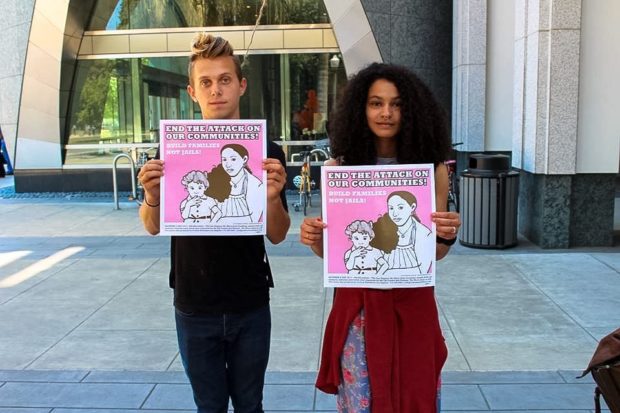
By Quentin Savage
On June 26, 2015, members of Californians United for a Responsible Budget gathered to disrupt Phase One of the Board of State and Community Corrections (BSCC) assembly in Sacramento. The following is excerpted from research compiled by Tash Nguyen of the Santa Cruz prison abolitionist group, Sin Barras. The BSCC was established in July 2012, replacing the Corrections Standards Authority, which had the responsibility of developing and maintaining state standards for local jails, juvenile detention facilities and training local corrections staff. In addition to these duties, the BSCC is tasked with finding new strategies around the management of the state’s criminal and juvenile justice populations.
The BSCC is made up of 13 people including the current chairperson, the director of the California Department of Corrections and Rehabilitation’s (CDCR) Department of Parole, two sheriffs, two probation officers, a county supervisor, a judge and two community-based service providers. The board only has one position open for community members.
The BSCC has four divisions: Corrections Planning and Programs, Facilities Standards and Operations, Standards and Training for Corrections, and Counties Facilities Construction. Within the Counties Facilities Construction division, there are different Executive Steering Committees (ESCs) that correspond to each separate jail construction funding plan.
Currently, construction funding requests submitted by counties are reviewed by ESCs that make recommendations to the BSCC about which counties will receive funding and in what amounts. The full Board makes the final decisions over funding. However, counties can also pay for jail construction by undertaking bonded debt, an option the L.A. County Supervisors have discussed considering.
Counties must match a minimum of 10% of the total construction project costs as a county contribution. The county contribution can come from the county’s general fund and/or county voter-approved taxes. In addition, each county will have to pay for operational costs. For example, in San Mateo County the jail will cost $160 million to construct, it will cost $30 million a year to operate and thousands more in county debt for decades to come.
The Sheriff’s Department has to obtain approval from the County Board of Supervisors to submit an Adult Local Criminal Justice Facilities Proposal to the BSCC. The BSCC has to award the county state funding that is divided out in different amounts based on county population.
The bill authorizes the state to borrow $500 million and to distribute the money to local governments to build, expand or “renovate” their jails and programming facilities.
Large counties: $80 million
Medium counties: $40 million
Small counties: $20 million
The first assembly of 2015 was held in Sacramento. Representatives from numerous California counties were in attendance, including Riverside, Santa Monica, Fresno and San Francisco.
Local organizers and activists from Critical Resistance, the California Prison Moratorium Project and Sin Barras also gathered with large banners reading STOP JAIL EXPANSION, CAGES KILL and INVEST IN PEOPLE NOT PRISONS facing the council.
Following a lengthy Q&A session, these groups, together forming the vanguard of Californians United for a Responsible Budget (CURB), began to chant “No New Jails.” The chant rose in tenor and eventually escalated into a series of marches through the aisles of the conference room. The party was pleased to find that their presence temporarily shut down the delegation as security escorted participants from the building.
*****
Quentin Savage organizes with the California Prison Moratorium Project. He is a volunteer with the broad-based coalition Californians United for a Responsible Budget.
